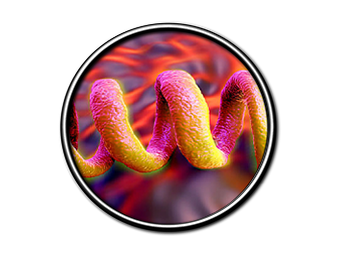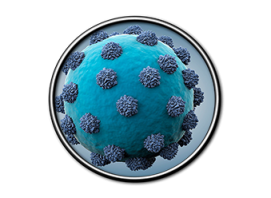Syphilis
What is syphilis?
Syphilis is a sexually transmitted disease (STD) caused by the bacterium Treponema pallidum. Syphilis can cause serious health sequelae if not adequately treated.
How common is syphilis?
During 2017, there were 101,567 reported new diagnoses of syphilis (all stages), compared to 39,782 estimated new diagnoses of HIV infection in 2016 and 555,608 cases of gonorrhea in 2017.1, 2 Of syphilis cases, 30,644 were primary and secondary (P&S) syphilis, the earliest and most transmissible stages of syphilis. In 2017, the majority of P&S syphilis cases occurred among gay, bisexual, and other men who have sex with men (MSM). In 2017, MSM accounted for 79.6% of all P&S syphilis cases among males in which sex of sex partner was known and 57.9% of all P&S syphilis cases overall. However, in recent years, the rate of P&S syphilis has been increasing among MSM as well as heterosexual men and women.
Congenital syphilis (syphilis passed from pregnant women to their babies) continues to be a concern in the United States. During 2017, 918 cases of congenital syphilis were reported, compared to an estimated 99 cases of perinatal HIV infection during 2016. 1 In 2017, congenital syphilis rates were 6.1 times and 3.5 times higher among infants born to black and Hispanic mothers (58.9 and 33.5 cases per 100,000 live births, respectively) compared to white mothers (9.7 cases per 100,000 live births).
How do people get syphilis?
Syphilis is transmitted from person to person by direct contact with a syphilitic sore, known as a chancre. Chancres can occur on or around the external genitals, in the vagina, around the anus , or in the rectum, or in or around the mouth. Transmission of syphilis can occur during vaginal, anal, or oral sex. In addition, pregnant women with syphilis can transmit the infection to their unborn child.
How quickly do symptoms appear after infection?
The average time between acquisition of syphilis and the start of the first symptom is 21 days, but can range from 10 to 90 days.
What are the signs and symptoms in adults?
Syphilis has been called “The Great Pretender”, as its symptoms can look like many other diseases. However, syphilis typically follows a progression of stages that can last for weeks, months, or even years:
Primary Stage
The appearance of a single chancre marks the primary (first) stage of syphilis symptoms, but there may be multiple sores. The chancre is usually (but not always) firm, round, and painless. It appears at the location where syphilis entered the body. These painless chancres can occur in locations that make them difficult to notice (e.g., the vagina or anus). The chancre lasts 3 to 6 weeks and heals regardless of whether a person is treated or not. However, if the infected person does not receive adequate treatment, the infection progresses to the secondary stage.
Secondary Stage
Skin rashes and/or mucous membrane lesions (sores in the mouth, vagina, or anus) mark the second stage of symptoms. This stage typically starts with the development of a rash on one or more areas of the body. Rashes associated with secondary syphilis can appear when the primary chancre is healing or several weeks after the chancre has healed. The rash usually does not cause itching. The characteristic rash of secondary syphilis may appear as rough, red, or reddish brown spots both on the palms of the hands and the bottoms of the feet. However, rashes with a different appearance may occur on other parts of the body, sometimes resembling rashes caused by other diseases. Sometimes rashes associated with secondary syphilis are so faint that they are not noticed. Large, raised, gray or white lesions, known as condyloma lata, may develop in warm, moist areas such as the mouth, underarm or groin region. In addition to rashes, symptoms of secondary syphilis may include fever, swollen lymph glands, sore throat, patchy hair loss, headaches, weight loss, muscle aches, and fatigue. The symptoms of secondary syphilis will go away with or without treatment. However, without treatment, the infection will progress to the latent and possibly tertiary stage of disease.
Latent Stage
The latent (hidden) stage of syphilis is a period of time when there are no visible signs or symptoms of syphilis. Without treatment, the infected person will continue to have syphilis in their body even though there are no signs or symptoms. Early latent syphilis is latent syphilis where infection occurred within the past 12 months. Late latent syphilis is latent syphilis where infection occurred more than 12 months ago. Latent syphilis can last for years.
Tertiary Syphilis
Tertiary syphilis is rare and develops in a subset of untreated syphilis infections;, it can appear 10–30 years after infection was first acquired, and it can be fatal. Tertiary syphilis can affect multiple organ systems, including the brain, nerves, eyes, heart, blood vessels, liver, bones, and joints. Symptoms of tertiary syphilis vary depending on the organ system affected.
Neurosyphilis and Ocular Syphilis
Syphilis can invade the nervous system at any stage of infection, and causes a wide range of symptoms, including headache, altered behavior, difficulty coordinating muscle movements, paralysis, sensory deficits, and dementia.3 This invasion of the nervous system is called “neurosyphilis.
Like neurosyphilis, ocular syphilis can occur at any stage of infection. Ocular syphilis can involve almost any eye structure, but posterior uveitis and panuveitis are the most common. Symptoms include vision changes, decreased visual acuity, and permanent blindness. Clinicians should be aware of ocular syphilis and screen for visual complaints in any patient at risk for syphilis (e.g., MSM, persons living with HIV, others with risk factors and persons with multiple or anonymous partners). A 2015 Clinical Advisory and a MMWR: Notes from the Field discuss recent reported cases and provide information for clinicians on the diagnosis and management of ocular syphilis.
How does syphilis affect a pregnant woman and her baby?
When a pregnant woman has syphilis, the infection can be transmitted to her unborn baby. All pregnant women should be tested for syphilis at the first prenatal visit. For women who are at high risk for syphilis, live in areas of high syphilis morbidity, are previously untested, or had a positive screening test in the first trimester, the syphilis screening test should be repeated during the third trimester (28 to 32 weeks gestation) and again at delivery.3 Any woman who delivers a stillborn infant after 20 week’s gestation should also be tested for syphilis.
Depending on how long a pregnant woman has been infected, she may have a high risk of having a stillbirth or of giving birth to a baby who dies shortly after birth. Untreated syphilis in pregnant women results in infant death in up to 40 percent of cases.
An infected baby born alive may not have any signs or symptoms of disease. However, if not treated immediately, the baby may develop serious problems within a few weeks. Untreated babies may become developmentally delayed, have seizures, or die. All babies born to mothers who test positive for syphilis during pregnancy should be screened for syphilis and examined thoroughly for evidence of congenital syphilis. 3
For pregnant women only penicillin therapy can be used to treat syphilis and prevent passing the disease to her baby; treatment with penicillin is extremely effective (success rate of 98%) in preventing mother-to-child transmission. 4 Pregnant women who are allergic to penicillin should be referred to a specialist for desensitization to penicillin.
How is syphilis diagnosed?
The definitive method for diagnosing syphilis is visualizing the Treponema pallidum bacterium via darkfield microscopy. This technique is rarely performed today. Diagnoses are thus more commonly made using blood tests. There are two types of blood tests available for syphilis: 1) nontreponemal tests and 2) treponemal tests. Both types of tests are needed to confirm a diagnosis of syphilis.
Nontreponemal tests (e.g., VDRL and RPR) are simple, inexpensive, and are often used for screening. However, they are not specific for syphilis, can produce false-positive results, and, by themselves, are insufficient for diagnosis. VDRL and RPR should each have their antibody titer results reported quantitatively. Persons with a reactive nontreponemal test should always receive a treponemal test to confirm a syphilis diagnosis. This sequence of testing (nontreponemal, then treponemal test) is considered the “classical” testing algorithm.
Treponemal tests (e.g., FTA-ABS, TP-PA, various EIAs, chemiluminescence immunoassays, immunoblots, and rapid treponemal assays) detect antibodies that are specific for syphilis. Treponemal antibodies appear earlier than nontreponemal antibodies and usually remain detectable for life, even after successful treatment. If a treponemal test is used for screening and the results are positive, a nontreponemal test with titer should be performed to confirm diagnosis and guide patient management decisions. Based on the results, further treponemal testing may be indicated. For further guidance, please refer to the 2015 STD Treatment Guidelines. 3 This sequence of testing (treponemal, then nontreponemal, test) is considered the “reverse” sequence testing algorithm.Reverse sequence testing can be more convenient for laboratories, but its clinical interpretation is problematic, as this testing sequence can identify persons previously treated for syphilis, those with untreated or incompletely treated syphilis, and persons with false-positive results that can occur with a low likelihood of infection.5
Special note: Because untreated syphilis in a pregnant woman can infect and possibly kill her developing baby, every pregnant woman should have a blood test for syphilis. All women should be screened at their first prenatal visit. For patients who belong to communities and populations with high prevalence of syphilis and for patients at high risk, blood tests should also be performed during the third trimester (at 28–32 weeks) and at delivery. For further information on screening guidelines, please refer to the 2015 STD Treatment Guidelines. 3
All infants born to mothers who have reactive nontreponemal and treponemal test results should be evaluated for congenital syphilis. A quantitative nontreponemal test should be performed on infant serum and, if reactive, the infant should be examined thoroughly for evidence of congenital syphilis. Suspicious lesions, body fluids, or tissues (e.g., umbilical cord, placenta) should be examined by darkfield microscopy, PCR testing, and/or special stains. Other recommended evaluations may include analysis of cerebrospinal fluid by VDRL, cell count and protein, CBC with differential and platelet count, and long-bone radiographs. For further guidance on evaluation of infants for congenital syphilis, please refer to the 2015 STD Treatment Guidelines. 3
What is the link between syphilis and HIV?
In the United States, approximately half of men who have sex with men (MSM) with primary and secondary (P&S) syphilis were also living with HIV.2 In addition, MSM who are HIV-negative and diagnosed with P&S syphilis are more likely to be infected with HIV in the future. 6 Genital sores caused by syphilis make it easier to transmit and acquire HIV infection sexually. There is an estimated 2- to 5-fold increased risk of acquiring HIV if exposed to that infection when syphilis is present. 7 Furthermore, syphilis and certain other STDs might be indicators of ongoing behaviors and exposures that place a person at greater risk for acquiring HIV.
What is the treatment for syphilis?
For detailed treatment recommendations, please refer to the 2015 CDC STD Treatment Guidelines. The recommended treatment for adults and adolescents with primary, secondary, or early latent syphilis is Benzathine penicillin G 2.4 million units administered intramuscularly in a single dose. The recommended treatment for adults and adolescents with late latent syphilis or latent syphilis of unknown duration is Benzathine penicillin G 7.2 million units total, administered as 3 doses of 2.4 million units administered intramuscularly each at weekly intervals. The recommended treatment for neurosyphilis and ocular syphilis is Acqueous crystalline penicillin G 18-24 million units per day, administered as 3-4 million units intravenously every 4 hours or continuous infusion, for 10-14 days. Treatment will prevent disease progression, but it might not repair damage already done.
Selection of the appropriate penicillin preparation is important to properly treat and cure syphilis. Combinations of some penicillin preparations (e.g., Bicillin C-R, a combination of benzathine penicillin and procaine penicillin) are not appropriate replacements for benzathine penicillin, as these combinations provide inadequate doses of penicillin. 8
Although data to support the use of alternatives to penicillin is limited, options for non-pregnant patients who are allergic to penicillin may include doxycycline, tetracycline, and for neurosyphilis, potentially ceftriaxone. These therapies should be used only in conjunction with close clinical and laboratory follow-up to ensure appropriate serological response and cure. 3
Persons who receive syphilis treatment must abstain from sexual contact with new partners until the syphilis sores are completely healed. Persons with syphilis must notify their sex partners so that they also can be tested and receive treatment if necessary.
Who should be tested for syphilis?
Any person with signs or symptoms suggestive of syphilis should be tested for syphilis. Also, anyone with an oral, anal, or vaginal sex partner who has been recently diagnosed with syphilis should be tested for syphilis.
Some people should be tested (screened) for syphilis even if they do not have symptoms or know of a sex partner who has syphilis. Anyone who is sexually active should discuss his or her risk factors with a health care provider and ask whether he or she should be tested for syphilis or other STDs.
In addition, providers should routinely test for syphilis in persons who
- are pregnant;
- are sexually active men who have sex with men (MSM);
- are living with HIV and are sexually active;
- are taking PrEP for HIV prevention.
Will syphilis recur?
After appropriate treatment, syphilis does not recur. However, having syphilis once does not protect a person from becoming infected again. Even following successful treatment, people can be reinfected. Patients with signs or symptoms that persist or recur or who have a sustained fourfold increase in nontreponemal test titer probably failed treatment or were reinfected. These patients should be retreated.
Because chancres can be hidden in the vagina, rectum, or mouth, it may not be obvious that a sex partner has syphilis. Unless a person knows that their sex partners have been tested and treated, they may be at risk of being reinfected by an untreated partner. For further details on the management of sex partners, refer to the 2015 STD Treatment Guidelines. 3
How can syphilis be prevented?
Correct and consistent use of latex condoms can reduce the risk of syphilis when the infected area or site of potential exposure is protected. However, a syphilis sore outside of the area covered by a latex condom can still allow transmission, so caution should be exercised even when using a condom.
The surest way to avoid transmission of sexually transmitted diseases, including syphilis, is to abstain from sexual contact or to be in a long-term mutually monogamous relationship with a partner who has been tested and is known to be uninfected.
Partner-based interventions include partner notification – a critical component in preventing the spread of syphilis. Sexual partners of infected patients should be considered at risk and provided treatment per the 2015 STD Treatment Guidelines. 3
SOURCE: CDC





